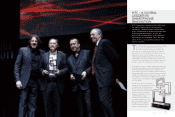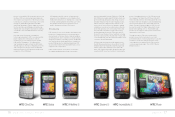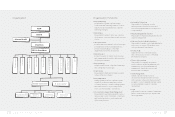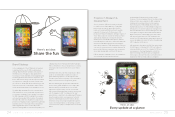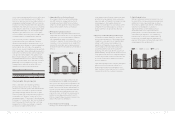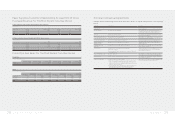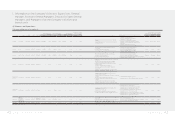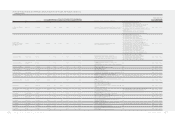HTC 2010 Annual Report Download - page 14
Download and view the complete annual report
Please find page 14 of the 2010 HTC annual report below. You can navigate through the pages in the report by either clicking on the pages listed below, or by using the keyword search tool below to find specific information within the annual report.
26 2 0 1 0 H T C A N N U A L R E P O R T 27
Business Operations
The wireless telecommunications sector
is in the midst of tremendous growth.
In response, mobile phone makers,
telecom service providers and software
developers have introduced countless
products and services that aim to
enhance and further popularize the
mobile internet.
Mobile phones are now digital music players,
web browsers, e-mail portals, high-speed
internet devices and GPS navigation tools.
They are an indispensible personal entertainment and
work platform. International research firm Gartner
reported that smartphone penetration rose from
14.2% in 2009 to 18.6% in 2010. Growth is expected to
continue for years to come.
So much functionality in the palm of your hand would
not have been possible without the coordinated
eort of multiple industries and countless companies.
Upstream smartphone suppliers include hardware
companies - experts in producing chips, panels and
batteries, among others, as well as software developers
that write operating systems, applications and other
programs. The quality of each input impacts directly
on final product quality and indelibly aects the user
experience. Companies like HTC - the middle link in
the chain of production - leverage technical expertise
to integrate software and hardware into a variety of
smartphone products tailored to the needs of dierent
market segments. Products then reach consumers
through downstream telecom service providers and
retail channels.
Data-centric 3G/4G wireless communication technology
has now superseded previous voice-centric 2G
standards. The move to 4G is particularly evident in the
United States, as US telecom providers seek to further
expand mobile multimedia services. For their part,
mobile phone makers continue to beef up products with
new features such as 1GHz processors, large screens,
enhanced resolution, intuitive touch interfaces, and an
INDUSTRY OVERVIEW





